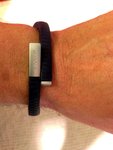 |
| Angelika/Mike Schilli |
|
|
|
Michael Sitting in the office all day is not healthy. Actively moving around is good for you and helps avoiding putting on those otherwise inevitable pounds around the waistline. But how many steps are you actually walking during the day, is it sufficient by the time you come home or should you run for half an hour on the tread mill or go for a late evening walk around the block on top of that? To find out about that, I've been wearing the bracelet in Figure 1 since beginning of August.
The so-called Up Band by a company named Jawbone tracks how many steps I'm going per day and how many hours of sleep I get during the night. On my smartphone, I can then look at colorful graphics and check how many calories I've burned, how long I've been sitting around inactively and how many times I woke up during the night. What's more, I can program the band to wake me up with a gently vibration when it's about time, but not when I'm deeply asleep, only when I'm already nervously moving in bed. Allegedly, waking up is less brutal this way.
Since Angelika is wearing a band herself, feeds the collected data into her smartphone, and chose to share it with me, I can now follow along with her sportive activities and make sarcastic comments if her step counter shows less than the recommended 10,000 steps at the end of the day. You can configure different goals if you like. If there's more people in your "team", this tends to spur competition and daily new records, because everyone wants to outperform the rest of the pack. At work at Yahoo, my colleagues actually started to rack up miles in the morning on training runs or hiked many miles on the weekends to temporarily take the lead in the group.
The Up Band simply tracks acceleration data while you're swinging your arms during walking or running activities. It won't notice whether you're actually moving and because of that it works just as well on a stepper or treadmill. It guesses the covered distance more or less accurately and if it's too far off, you can recalibrate it with manually entered data from an external GPS tracker like the one built into your smartphone. Of course, you could easily trick the device by attaching it to a crawling toddler or a pet, but that would be cheating!
The new-fangled gadget is not exactly cheap at a price of $130, and if you have bad luck, it stops working after a while, as seen with some of my colleagues at work. But that's the price for chasing the latest fashion trends and being the first to try out new gadgets. And I can confirm that the band does turn heads and is a great conversation starter, it's very common that random people inquire about it. Top product!
Greetings from Europe's future:
Angelika & Michael














